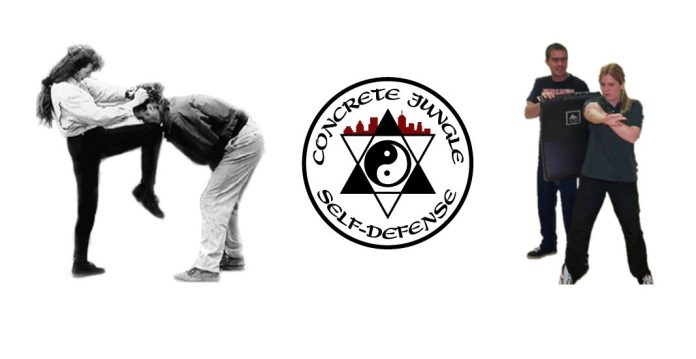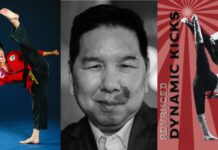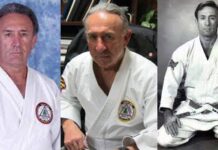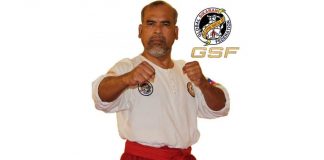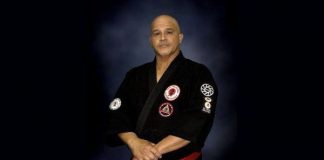After reading a disturbing account in a local newspaper of the abduction and murder of two young sisters, Cordelia Clancy created Concrete Jungle Self-Defense™ to train ordinary people how to become their own bodyguards. Today, Clancy and partner Mark Wightman, train people from all walks of life, from school students to military personnel, from corporations to government agencies. Her story and philosophies are wide, varied and hard hitting. Many of us can appreciate the reasons why she decided to begin Concrete Jungle.
1. Tell us a little something about yourself. At what age did you begin training and why?
My dad was a champion amateur boxer in Ireland. One of my earliest memories, around four years old, is standing on his lap punching air out of his inflated face cheeks, causing anti-social noises to our mutual amusement. As kids, Dad taught my brothers and I to hit hard,fast and first if we were picked on by bullies. He taught us strategies such as hit “mid-threat” before the person has finished announcing their intent. People expect to finish their sentences. It’s a great time to nail them.
When I was a teenager, an older bully jumped my little brother and kicked him unconscious with steel capped boots. When I found out what had happened, I was outraged. I also felt terribly guilty I had not been there to protect him.
A few days later, on my way home from school the bully got in my face and announced I was “In for a kickin’ like my baby brother”. Well, hell hath no fury like a protective, pissed off female. I unleashed on him, and in the course of the fight broke his nose with a headbutt, split his lips, and bit and tore any flesh that come close to my mouth… He was a mess by the time I was pulled off him, my catholic school uniform spattered in his blood, my baptism into streetfighting.
I realized then the power of an offensive mindset, of being ruthlessly committed to hurting an opponent. If I was going down, the bastard was going to get some serious pain,too. He looked really bad for a couple of weeks with stitched lips, a broken nose and puffy black eyes. To save face he said both of my brothers had attacked him, but witnesses spread word around the neighborhood that the bully, “Murphy”, had got his arse kicked by a girl. He learned the golden rule: Never under-estimate an opponent. He stopped picking fights after that.
2. What was your first martial arts style?
Apart from boxing and scrapping with various bullies, my first formal martial art was Lau Gar Kung Fu under Kevin Brewerton, holder of European Championship Titles in Kickboxing and freestyle. Next I trained in Tukong Moosul with Grandmaster Wonik Yi, former instructor of the South Korean Special Forces and Tiger Teams.
3. Was there a particular well known martial artist or movie star that attracted you to the arts?
Growing up, my favorite TV show was Kung-Fu with David Carradine. I loved the wisdom of the temple masters and the gentle warrior priest who protected those unable to defend themselves and stood up for justice against any odds. It was as though the life lessons and martial art training stirred deep parts of my soul. I felt I was awakening to, or maybe remembering, something important. I knew the the warrior path of wisdom and strength, courage and peace was a path I wanted to walk.
4. What did your first training sessions consist of? (work outs)
Classes were at least two hours. The first hour was an intense circuit of cardiovascular conditioning and fast twitch muscle drills: stretching, elevated leg push-ups, squat-thrusts, crunches, reverse crunches, sprint drills, shadow work, jumping, you name it we did it. At a furious pace too! The second hour was chi training, techniques, kata and sparring.
When I first started training at fifteeen, I was intimidated by high kicks to the head, and the prospect of being knocked unconscious. On my second class, to confront my fears, I asked the biggest guy there if I could spar with him. During the bout he landed a beautiful spinning kick to my head. Lights out. I regained consciousness a few moments later and told my concerned partner: No worries mate, I’m fine.
It was really a liberating experience for me. I now knew what it felt like to get knocked out and it wasn’t as bad as I had expected. It was just very bright for a second, then dark. No big deal. I was glad I had experienced this right off the bat, so I didn’t have to carry the fear of being knocked out into the rest of my training.
5. Tell us about your travels….where did you grow up and where do you live now?
I grew up outside of London and spent a lot of my childhood vacations in beautiful Ireland, in the South where it is not occupied by British troops. I was a mountain bike tour guide in Tahiti and Moorea. I’ve been to Paris and I’ve surfed the Gold Coast in Australia. I lived in Austin, TX for over four years training in Tukong Moosul, and now live in Northern California . I travel around the US to teach and also to Mexico. I’ll be teaching in Central America later this year and I can’t wait to check out the jungles and rainforests.
6. How did you get to become an executive protection specialist?
I started out informally by word of mouth doing protective duty for film and TV personalities and occasional witness protection work. I got my formal certification through a bodyguard training course at the International Institute of Professional Executive Protection.
7. You train in Tukong Moosul..can you explain that art?
Tukong Moosul was developed for the South Korean Special Forces and Tiger Teams to train them in hand-to-hand combat, jungle warfare and counter terrorist tactics. Tukong Moosul means “Special Combat Warrior Martial Art”. It is a comprehensive, eclectic system designed by taking the best elements of many martial arts and integrating them into a complete system. The hand-to-hand element was designed to go up against and defeat any system the soldiers might encounter in their operations.
8. Is this art more of a close range confrontational system? Since it is used to train Korean special forces are there high kicks involved like those in Tang So Doo and Tae Kwon Do?
Tukong Moosul covers all the combat ranges from outside kicking range to middle range, close range and groundfighting. It also covers the whole continuum of the levels of force including releases, pain compliance techniques, injuring force and of course, deadly force.
High kicks are taught in training for a couple of reasons including flexability and conditioning. Most importantly, you learn how to deal with these types of kicks if they are thrown at you. Our system incorporates a lot of trapping and sweeping techniques to counter high kicks, but you must learn how to do these kicks in training in order to practice the counters. We advocate low kicks as far more practical in combat situations.
9. Counter terrorist tactics are more than punch/kick…what sort of information can you tell us to describe the art in detail?
A huge question! A general overview would include the following: Threat assessments; Profiling terrorists or other enemies: causes, MO’s and psychological profiles if available; Pro-active counter measures such as awareness expansion training; Electronic surveillance and counter-surveillance; Securing a vehicle from tampering, route planning and reconnaissance, counter terrorist tactical driving for ambush kidnap or assassination attempts; Home and workplace safety analysis; Security program design and implementation, including levels and perimiters of security, mail bomb detection, screening employees; Executive travel safety including advance work, low key travel, the safest place to sit on an aircraft, etc.
10. You’ve also created Concrete Jungle Self Defense. Can you explain how that came about?
I was motivated to develop and teach these courses after reading a tragic report in the local newspaper involving two young sisters, Maria and Amy Brown. The girls were set up by two men who let the air out of their car tire while the girls were inside a convenience store. These men offered to help the girls when they came back out. Oblivious to the set up, the trusting young girls went with them to get new tires. They were abducted and taken to a remote bridge overlooking a deep canyon.
The girls were severly beaten and brutally raped. They were then tossed from the bridge into the canyon by their assailants. The younger sister, eleven year old Amy, died at the scene of massive injuries. The older sister Maria, 19, although severly injured, survived.
I have a teenage sister and this story struck a deep chord, haunting me for weeks. I realized that there was a desperate need to teach people how to be pro-active and well trained regarding their own safety. Maria had told police:” All we could do to was beg for our lives… but the men just laughed and threw us off the bridge like rag dolls.”
It didn’t have to be this way. Good people should not need to beg for their lives or wait for the cavalry to show up to save them. I resolved that I would now train people how to become their own bodyguards, sharing the best of my knowledge and skills with any man, woman or child who wanted to learn how to take care of themselves or protect the people they love.
11. Does your system take a while to learn or is it a no holds barred down and dirty NEEDED system for a novice in the martial arts?
We offer a two month intensive course, and seminars. It may not sound like a whole lot of time, but we train people incredibly effeciently from the very first minute. They can literally learn more street effective techniques in our course than they did in years in a traditional martial arts school. Everything we teach is illegal in tournaments.
With Smartfighting (TM) you can get very good, very quickly, which is why it is ideal for military and law enforcement personnel and busy civilians who do not have time to train for years to learn how to defend themselves.
From day one students practice mental and physical training together at an intense level. The Combat Mindset is so important. Many schools neglect to teach this, so when a fight happens, a student who has not trained mentally for real aggressive combat can psychologically fall apart, no matter how skilled they are physically. I had learned the value of an aggressive attitude early in life, in defeating bigger bullies.
We tell students to pick a “combat mantra” for want of a better word,their most aggressive thought (usually “F**K YOU!”) Every time they throw a technique, it’s full force on equipment, visualizing the real body target and fueled with this ruthless, combative thought.
If we can click into an aggressive mindset and ,for example, stab a pen or fingers deep into an opponent’s eye, we’re well on our way to defeating him. Simple. Brutally effective. Easy to learn. Those are the requirements for the techniques and types of combinations we teach.
12. Can seasoned martial artists learn from this system as well?
Definately! What can happen sometimes to those who have trained for a long time is information overload. People can have problems prioritizing techniques. If you know fifty defense combos against a punch, which one do you do when the shit hits the fan?
Smartfighting (TM) shows fighters how to select the most brutally efficient techniques depending on three major factors: What range are they at? (a technique thrown out of range is ineffective); What targets are open on your opponent; What weapons (bodily or otherwise) do you have available to destroy these targets.
The beauty about Smartfighting ™ is in it’s simplicity, based on solid combat and scientific principles. For example: a lot of us martial artists learn techniques that incorporate a punch to the face. Well, if we punch someone’s head, we are likely to break our weaker knuckles on their harder skull. Bad idea. Boxers need to tape, wrap and wear a couple of inches of padded gloves to protect their hands.
Also, look at the amount of trauma a person can take from punches: eleven rounds of hundreds of punches thrown at you. Not very effecient, is it? One of the principles of Smartfighting ™ is use a harder weapon against a weaker vital target (fingers to eyes, flat knuckles to throat etc.) That way the target gives, and not your bodily weapon. Basic physics.
13. The phrase “Think like a bodyguard and fight like a marine” is quite a statement. What kind of people visit and train with you?
We train an amazingly diverse student body ranging from military special operations guys, law enforcement and security personnel, government agency field personnel, professional athletes, students, business people, even news reporters and camermen (who came to feature the course then signed up). Men and women of all ages and physical conditions, from all walks of life and socio-economic backgrounds.
Learning how to protect your life and loved ones strikes a chord across the spectrum of society. It doesn’t matter how great your life is, how wealthy you are etc. if someone can take it all away from you in an attack. Learning to take care of ourselves in a universal requirement for our journey of life on planet earth.
14. It seems avoidance of a situation can also be a self defense measure. Is that an option when needed?
The major goal of our training is to help people stay out of harm’s way. When we say “Think like a bodyguard…” a bodyguard’s job primarily is to AVOID problems. If you get to the point where you need to get physical, that’s bad news. Every one has vital points, we all can get hurt or die.
You “…fight like a Marine” only as a last resort. But you MUST know the bottom line in case the other levels of avoidance fail you.
Awareness is the first line of defense, being attuned to your environment with all of your senses, including your intuition, to pick up on a potential problem, do a threat assessment and select an appropriate response.
Avoidance is physically implementing risk reduction and/or de-escalation strategies to avert the potential of engagement. Kind of like a game of chess or staying a step ahead of the bad guys by making yourself a harder target. Avoidance is by far preferable to engagement, so we teach extensive pro-active preventive strategies.
15. Your training also encompasses some non traditional weapons…what can be used as a weapon in a real self defense situation?
Let’s just say that there are a lot of things in your environment that can be used to “Reach out and touch someone” and give them an abrupt shift of consciousness! Pens, picture frames, screwdrivers, a plastic deodorant stick, a cell phone, book, a potato…you’d be amazed! I like Pakal “Ice Pick” hairsticks, the one’s I’m wearing in these pictures. Inconspicuous (element of surprise) yet accessible and deadly. We’ll have these available from our web site. Pens can be used in a similar way by men or women. Think about it. Where would it be worst to get stuck with a pen?
16. Many people say 80% of all fights end up on the ground. Is this a true statement and if so what can be done to counter that?
I’m not aware of the source or authenticity of that statistic. The important issue though, is that fights can go to the ground at some point, so it’s wise to know what to do if it does go there.
As for counters, I would say if your gut tells you are about to be attacked, or your adversary announces his intent, go on a vicious offensive and start “Pulling the Plugs” of vision, breathing and locomotion on your opponent. In a split second you can do severe damage to the eyes or throat, which can stop an opponent from being able to hurt you, or destroy his inclination to fight you further, as he now worries about his own wellbeing.
It’s possible to also counter-attack while being tackled, by for example grabbing his head and gouging the eyes, on the way down. On the ground, although good to know how to do submission holds for some situations, realize that we cannot necessarily trust a guy who says he gives up just because he hurts from a joint lock. He may come back at you if you let him free. There are no rules or codes of honor in streetfights, so I say do whatever it takes, the dirtier the better.
Chokes are great if you can get them on quickly, but remember on the ground we are also in eye-gouge, bite and elbow smash range. The ground is a dangerous place to be. There’s the possibility of being stuck with a weapon you may be unaware of. You may be stomped by his buddies while you fight your opponent. So, “Do unto others before they do it to you.” Get the job done quickly (we recommend eye and throat trauma) and get up off the ground as soon as possible. Then you can stomp him if necessary.
17. Many civilians look at crime and criminals as super human. What can be done to let a person realize that a criminal is not always the champion street fighter that we think..or are they?
I think these attitudes stem from fear of the unknown, a self-imposed ignorance by choosing to live in a bubble of denial that anything could happen. Also these fears stem from abdicating responsibility for personal safety to police forces and the judicial system.
People also give up their power by being psychologically dependent on an external device or some imaginary hero to save them. Look at the popularity of personal alarms. Alarms are “Hero, please save me!” devices, usually ignored. People just turn up the TV if they hear one going off. How many people run out to see what’s going on every time a car alarm goes off? How many know the difference between a car alarm and a personal alarm?
Criminals are by no means superhuman, but they range from incompetent to sophisticated and ruthless. The one thing they have in common is their mortality, the same as all of us. What criminals usually have over the average civilian is the willingness to harm another person.
In our civilized society we have been conditioned (especially women) to supress our aggression. This is appropriate most of the time but not in a life or death confrontation. Nature gave us the gift of aggression in our toolbox for our survival. We need to acknowledge it, honor it and use it when necessary to protect ourselves. Remember, anyone is physically capable of hurting anyone. A five year old can stab a fork in your eye and you are screwed.
Remember the incident last year where a hijacked aircraft ran out of fuel and crashed in the ocean off an island resort, killing most of the passangers on board? The hijackers were not even armed. They had a fire extinguisher, that’s it! The pilot survived and stated afterwards “If only someone had challenged them…maybe all those people would not have had to die.”
We can all be that someone. We should all learn to be our own hero. Isn’t it better to take the chance for our lives, or if our number is up, go out like a lion instead of a lamb? A warrior does not fear death. Fear itself is a worse enemy, shackling us throughout life unless we overcome it. Abdicating responsibility for our safety, fear and self-imposed helplessness allow people to die in hijackings and holocausts. And in their own beds.
We need to start with a shift in our thinking. Imagine a criminal in a skimask (the scary unknown) who wants to harm or rape you. Instead of being intimidated by it, we can shift our mindset to ‘You’re going to need that mask you son-of-a-bitch by the time I’m finished with you!’
So, what can we do? Take responsibility for our own safety. Get educated on how to be pro-active. Understand criminal MO’s. Implement avoidance strategies. Know how to hurt them back and be prepared to do it to them first. An excellent book I recommend to people starting out on this personal inner shift is Awakening the Warrior Within, by Dawn Callan.
18. You are currently writing a hand to hand combat manual. Can you explain?
I am writing a manual on Principles of Smartfighting (TM). Without the solid foundation of principles, fighting responses can be haphazard, inappropriate and ineffective. Principles are the glue which bring martial arts knowledge into a cohesive,integrated whole. Master Swordsman Miyamato Musashi wrote in his classic ‘ Book of Five Rings’, by understanding principles ” from one thing you will know many things”. Learning and applying Smartfighting (TM) principles will help you become ruthlessly effective and efficient, essential elements in a life threatening combative situation.
The book will be a guide to fighting smart with maximum proficiency. It’s intended to be a valuable reference to law enforcement, security, and military personnel, martial artists of all disciplines and anyone taking hand-to-hand combat or self defense courses.
19. What other systems are in your arsenal?
Techniques from Muay Thai, Boar Bando, the Filipino arts… I take the strengths of the systems I’m exposed to, and discard what is inefficient, or is too complex to pull of in a critical incident. For example, from boxing I’ll take the hand speed, footwork, body movements, but replace the jab with a eye stab with fingers or a cross with a modified flat knuckle panther strike to the throat.
I’m also receiving tactical firearms training from one the best instructors in the country, Walt Marshall of Advanced Weapons and Tactics. Firearms are an important link in the chain of modern combat preparedness training. Most martial arts schools, however, do not yet incorporate this element of training.
20. You have quite a life…you do scuba diving…surfing…mountain biking…when do you have time for all that?
I have to make time for it. I’m want to enjoy my youth, my freedom and my healthy body while I have them. There’s a truism that goes something like: We spend our youth accumulating wealth, and our wealth trying to buy back our youth! That’s sad.
21. How can someone get in touch with you if they would like to train or are there schools around the country that would soon or are now training individuals in this type of art?
We will train groups anywhere in the country. I can be reached at Concrete Jungle Self-Defense in San Jose, CA at 408-257-2042 or by email at clancy@concretejunglesd.com. Our web site is www.concretejunglesd.com
Schools that teach similar content are pretty rare but they do exist. I think those of us who train this way represent the the wave of the future in personal defense training. There is Modern Warrior in Lindenhurst, NY. Progressive Fighting Systems in Southern CA with Paul Vunak in Los Angeles and Roy Harris in San Diego. Frank Cucci in Virginia…I’m sure there are other excellent schools. People must be prepared to do their homework and be educated consumers when scouting out a good system. It’s well worth making the effort to locate great instructors.
And it’s not about learning how to become a bad ass. If that’s the motivation we miss the whole point. It’s about accessing the inner strength to be who we want to be, the highest expression of ourselves, unshackled by fears. The quality of our lives is enhanced in so many ways. I have met wonderful people by starting up a conversation in line somewhere, or stopping to help a stranded motorist in a remote area. We’re taught to come from fear, to avoid strangers, to be suspicious of people we don’t know. We miss out on so much if we live that way. If we come from a place of strength and are in touch with our intuition to warn us of problems, we can move differently, with more freedom, through our lives.
One of my favorite observations on the rewards of accessing the hero/warrior archetype within us, came from a great teacher and wise elder of our society, the late Joseph Campbell:
“We have not even to risk the journey alone, for the heroes of all time have gone before us. The labyrinth is thoroughly known. We have only to follow the thread of the hero path, and where we would have thought to find an abomination, we shall find a god. And where we would have thought to slay another, we shall slay ourselves. Where we would have thought to travel outward, we shall come to the center of our own existance. And where had we thought to be alone, we shall be with all the world…”
I wish you well on your own unique journey.
Thank you Cordelia. Best of luck to you with your training and your Concrete Jungle Self Defense.
by Ben Smith, Martial Arts Magazine

For more information about Cordelia Clancy and Concrete Jungle Self Defense visit their listing on the Martial Arts Schools and Businesses Directory by clicking on the image on the left.

